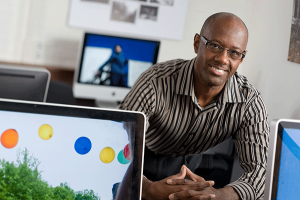Q&A with Chuck Stone Program co-director Terence Oliver

Associate professor Terence Oliver is an award-winning motion graphics producer who joined the UNC Hussman School of Journalism and Media faculty in 2010. He is co-director of the school’s Chuck Stone Program for Diversity in Education and Media. Oliver was the school’s 2012 winner of the Edward Vick Prize for Innovation in Teaching. He lives by the mantra: “To make a difference, be the difference.”
The Stone Program honors the legacy of former professor Charles Sumner Stone Jr. After an extraordinary career as a journalist, editor and author that included stints as an international aid worker, political aide and TV commentator, Stone taught journalism courses as one of the most popular professors at UNC from 1991 until his retirement in 2005.
The deadline to apply for the 2016 Chuck Stone Program for Diversity in Education and Media is March 1, 2016. Click here to apply.
UNC senior Sasha Perea sat down with Oliver to learn more about the program.
Q: How important is it to emphasize diversity in education and media?
A: It is very important. It has always been important. But it’s even more important now in a broader sense because the world is changing. People are not functioning in silos as much. The makeup of the United States is changing. Being able to tell people’s stories with a broader perspective is always a good and worthy cause. It just broadens everyone’s experience and world views and enriches society. I think there’s a broad impact that people don’t always realize.
Q: What is the structure of the program?
A: The structure of the program is like a summer camp where students come together as a team for about five days. They are exposed to various components of storytelling, such as photography, graphic design, writing, broadcast and other aspects that they may not have had the opportunity to be exposed to yet. It helps them engage with different types of storytelling on a collegiate level.
Q: Tell us about the connections made between faculty members and students.
A: The students who come are exposed to various professors and professionals who offer different practical skills and technical advice. The beautiful part of it is that the connections are ongoing. Once the students make the connections, they can reach out in the future. Once you become a Chuck Stone Scholar, regardless of if you come to UNC or not, you’re a Chuck Stone Scholar for life. And so we try to be all-inclusive with everything going forward. To welcome them back on campus or help them make decisions. Or whatever advice or coaching or mentoring that is available to the Chuck Stone students on campus, we try to have an outlet so that they remain a part.
Q: What kind of skills and hands-on experiences will students walk away with from this program?
A: Students walk away with a good grounding and coaching in writing and editing. They collaborate with various projects and walk away with collaborative skills. They walk away with hands-on training in graphic design and motion graphics, which is partly animation. They walk away with experience in the various roles of broadcasting on both sides of a camera and hands-on editing in a studio. They get photography training and challenges to shoot and edit photos.
Q: What originally drew you to the Chuck Stone Program for Diversity in Education and Media?
A: What drew me was the opportunity to help young people who want to transition to media and journalism — and to help underserved students get through obstacles and have new opportunities. I first participated as a professor sharing graphic design and motion graphics information. In the last two years, I transitioned into the leadership of the program.
Q: How have you been able to incorporate your personal and professional experiences in this program?
A: I’ve been able to because I come from an underserved community. I’ve been able to share my experiences and also help them through my experience and my passion. I’ve spent almost two decades in this industry, and I am able to share experience during teachable moments or help guide them with advice that goes beyond technical aspects of graphics or photography. It gets a little bit deeper. It meets needs that aren’t traditional.
Q: What have students said is their favorite part about the program?
A: The diversity, skills, experiences and just how much that they can get within that short span of time as takeaways.
Q: What is your favorite part of the program?
A: My favorite part is seeing students blossom and understand their potential. Most of them come in knowing that they have some potential, but we hone in on that. Just seeing the results of them engaging with one another and stirring that hunger from within.